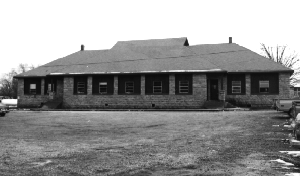Listed in Arkansas Register of Historic Places on 12/01/04
SUMMARY
SUMMARY
Constructed in 1928, the Mountain View Special School District no. 30 School is being nominated to the Arkansas Register of Historic Places with local
significance under Criterion A for its association with the development of schools and the public education system in Stone County. The school is also
being nominated under Criterion C as an excellent example of early 20th century craftsman style architecture, and because it genuinely reflects the
style of construction commonly used in Stone County for public and commercial buildings during the early half of the 20th century. This nomination
is being submitted under the multiple-property listing “Public Schools in the Arkansas Ozarks, 1920-1940.”
ELABORATION
ELABORATION
Stone County was created by an act of the Arkansas General Assembly April 21, 1873. The county was created from parts of Izard, Independence, Searcy
and Van Buren counties and was named for the abundant rock formations of the area. The landscape of the county is framed by the rugged Ozark Mountains.
The northern part of the county contains part of the Ozark National Forest, and the county’s eastern boundary is formed by the White River, known throughout
the country for its scenic beauty, excellent fishing, and other outdoor opportunities.
Stone County is home to two unique attractions. The first is Blanchard Springs Caverns, a three-level cavern system operated by the US Forest Service. The caverns, thought of by some as the cave discovery of the century and one of nature’s outstanding works of art, are still in the process of formation and include the world’s largest flowstone formation. The caverns are considered “living caves” because they continue to change and develop over time. Walking tours for two of the caverns are available, but the third cavern is yet undeveloped.
The second attraction, The Ozark Folk Center, is a unique state park devoted to preserving Ozark crafts, music, and heritage. The center was constructed
in 1973 and occupies 80 acres of a 637-acre site. The Ozark Folk Center provides traditional craft demonstrations, live music performances, living
histories, apprentice programs and workshops to help tell the story of the mountain culture of Stone County. The Ozark Cultural Resource Center houses
the park's extensive collection of folklore.
The economic base of Stone County is poultry, livestock, wood and iron products, and light manufacturing, but the largest industry is tourism. However,
Stone County is best known for two major assets: its mountainous beauty and the culture of its mountain folks. Numerous festivals are held each year
in celebration of the unique, and sometime quirky, way of life given to this part of the state. A sense of local pride and a fondness for tradition
exists among the county’s citizens, and efforts to preserve the scenic beauty and heritage of this place are numerous.
The Mountain View Special School District No. 30 School was built in 1928 to replace its forerunner, the Stone County Academy, which stood near the
same site. The new school was built to house the newly formed Special School District No. 30, which combined the local districts of Mountain View,
Oyler’s Chapel, Richwoods, and Levisy Flat. For ten years, this school was the sole facility for the entire district grades one through twelve. In
1938, a new facility was built next to the original school to house the high school grades and gymnasium. Circa 1943, the upper elementary moved in
to a new facility located across campus from the original school. This left the original building to house the primary grades of one through three
for around 30 years. From 1943 to 1974, the building remained mostly unchanged. In 1974, a new lower elementary school was built, leaving the original
school vacant for the first time since its construction. From 1974 to 1984, the building housed a band hall and the kindergarten. For this purpose,
many changes were made to the building, including the replacement of the original windows. In 1984, the entire school moved to a new campus, at which
time the Stone County Historical Society, the City of Mountain View, and Stone County jointly purchased the building. Currently, part of the school
is dedicated to the Stone County Historical Museum, part is used for storage, and part is rented.
SIGNIFICANCE
STATEMENT OF SIGNIFICANCE
Constructed in 1928, the Mountain View Special School District no. 30 School is being nominated to the Arkansas Register of Historic Places with local
significance under Criterion A for its association with the development of schools and the public education system in Stone County. The school is also
being nominated under Criterion C as an excellent example of early 20th century craftsman style architecture, and because it genuinely reflects the
style of construction commonly used in Stone County for public and commercial buildings during the early half of the 20th century. This nomination
is being submitted under the multiple-property listing “Public Schools in the Arkansas Ozarks, 1920-1940.”
BIBLIOGRAPHY
BIBLIOGRAPHY
Personal Interview. Luther, Edwin. June 2003.
E-mail Interview. Massey, Freda. 20 August 2003.
E-mail Interview. Labert, Stephanie. 2 June 2004.
